Foundry is a factory engaged in production both ferrous and non-ferrous metal castings. The type foundries specialize in casting metal fonts primarily used in printing industry. Today technology has given way to e-foundry, which is a type foundry that develops digital fonts with the aid of electronic tool.
Foundry Process-Step-by-Step InstructionsThe entire foundry process can be summarized in nine steps discussed below:
MoldingMolding is preparation of a mold for holding the molten metal. First a molding aggregate is placed around a pattern held with a supporting frame. The pattern is removed to form a mold cavity followed by setting the cores in the cavity, finishing and finally closing the mold.
Pouring the Mold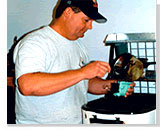 Once the molds of original sculpture are ready a process called "Slushing" for making wax reproductions follows. Slushing involves pouring in and out of molten wax in slushing movement to form ¼ inch thick wax layer in the mold. On cooling, the wax is removed and the mold is checked for imperfections.
Once the molds of original sculpture are ready a process called "Slushing" for making wax reproductions follows. Slushing involves pouring in and out of molten wax in slushing movement to form ¼ inch thick wax layer in the mold. On cooling, the wax is removed and the mold is checked for imperfections.
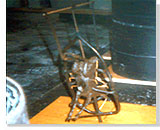 Wax chasing involves cleaning of the wax reproduction and adding finishing touches to the imperfections caused during molding. Spruing involves core pinning, which is insertion of copper pins at key positions into the wax reproduction. Next a steel rod is inserted through the piece and attached to the base, followed by building a network of sprues, gates and risers around the piece. The network of gates and sprues act as channels for the molten bronze and risers function as vents for hot air.
Wax chasing involves cleaning of the wax reproduction and adding finishing touches to the imperfections caused during molding. Spruing involves core pinning, which is insertion of copper pins at key positions into the wax reproduction. Next a steel rod is inserted through the piece and attached to the base, followed by building a network of sprues, gates and risers around the piece. The network of gates and sprues act as channels for the molten bronze and risers function as vents for hot air.
 Investment process involves placing the sprued piece in a flask made of roofing felt and wire, followed by sealing the bottom of the flask by plaster. Investment material formulated using the right combination of 70% silica powder and 30% pottery and water are mixed and then added to the flask ensuring that the entire wax piece is immersed. Once the material begins to set a pouring cup is cut on the top of the mold through the spruce system.
Investment process involves placing the sprued piece in a flask made of roofing felt and wire, followed by sealing the bottom of the flask by plaster. Investment material formulated using the right combination of 70% silica powder and 30% pottery and water are mixed and then added to the flask ensuring that the entire wax piece is immersed. Once the material begins to set a pouring cup is cut on the top of the mold through the spruce system.
 The well-set molds are transferred to a custom-built furnace platform after removing the felt covering of the flasks. Gas blowers are inserted through the ports of the furnace and a high volume vent is placed above. Burning out begins by ignition of the gas blowers and is regulated by computer-monitored thermostat. The time required burnout is determined by the dimensions of the largest flask in the furnace.
The well-set molds are transferred to a custom-built furnace platform after removing the felt covering of the flasks. Gas blowers are inserted through the ports of the furnace and a high volume vent is placed above. Burning out begins by ignition of the gas blowers and is regulated by computer-monitored thermostat. The time required burnout is determined by the dimensions of the largest flask in the furnace.
 After burnout the furnace is dismantled and the hot flasks are buried in a sandpit, to keep them hot until molten bronze is ready for pouring. Bronze ingots placed inside crucibles are heated in the bronze furnace. On reaching a constant 2100 degrees the crucibles are removed and set in crucible shanks. On removing the impurities and reconfirming the temperature the crucibles are ready to pour the bronze into the flasks.
After burnout the furnace is dismantled and the hot flasks are buried in a sandpit, to keep them hot until molten bronze is ready for pouring. Bronze ingots placed inside crucibles are heated in the bronze furnace. On reaching a constant 2100 degrees the crucibles are removed and set in crucible shanks. On removing the impurities and reconfirming the temperature the crucibles are ready to pour the bronze into the flasks.
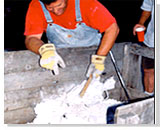 On cooling the molds are removed from the sandpit and later broken. Remaining investment material is removed using high-pressure washer and sand blasters. The spruces are then cut and finally the pieces are welded in place using an argon tieg welder.
On cooling the molds are removed from the sandpit and later broken. Remaining investment material is removed using high-pressure washer and sand blasters. The spruces are then cut and finally the pieces are welded in place using an argon tieg welder.
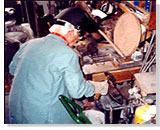 The imperfections and details lost during the casting process are chased back into the piece in this step. After sand blasting the piece gets ready for patination.
The imperfections and details lost during the casting process are chased back into the piece in this step. After sand blasting the piece gets ready for patination.
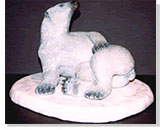 The appearance of the sculpture depends on the patina, which is usually prepared by mixing variety of acids and chemicals. On heating the chemicals bond and once the desired patina the sculpture is sealed by wax or lacquer to avoid discoloration. The piece is mounted on a suitable surface and is ready for display.
The appearance of the sculpture depends on the patina, which is usually prepared by mixing variety of acids and chemicals. On heating the chemicals bond and once the desired patina the sculpture is sealed by wax or lacquer to avoid discoloration. The piece is mounted on a suitable surface and is ready for display.
Casting foundries have become an integral part of our lives. Foundries contribute heavily to the automotive, electric, petroleum and machining industries. A foundry can either produce sand casts, die or permanent mould casts. A foundry allows the consumer to have a smooth, textured, durable and non-corrosive product.
